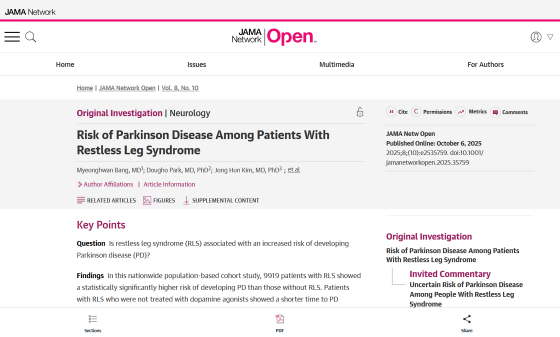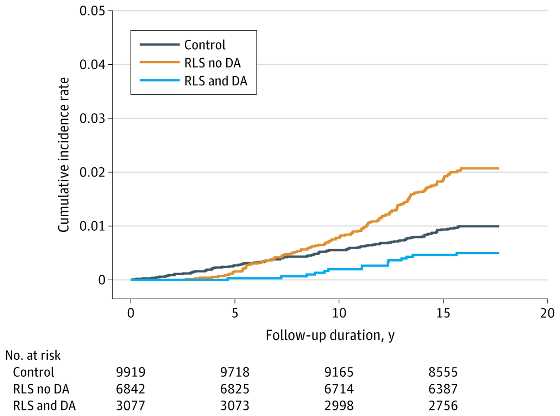Treatment for restless legs syndrome may reduce risk of Parkinson's disease

Risk of Parkinson Disease Patients Among Patients With Restless Leg Syndrome | Neurology | JAMA Network Open | JAMA Network
https://jamanetwork.com/journals/jamanetworkopen/fullarticle/2839651

Restless Legs Treatment Slashes Increased Risk of Parkinson's Disease : ScienceAlert
https://www.sciencealert.com/restless-legs-treatment-slashes-increased-risk-of-parkinsons-disease
Restless legs syndrome and Parkinson's disease are both conditions characterized by impaired motor control and are treated by administering dopamine agonists , which mimic the neurotransmitter dopamine and activate dopamine pathways.
Because restless legs syndrome and Parkinson's disease share similar characteristics, researchers have long suspected a link between the two. Some researchers speculate that restless legs syndrome may be an early clinical symptom of Parkinson's disease, suggesting a weakening of the dopamine pathway. However, previous research has been limited or unclear about the relationship between the two, leaving the details unclear.
The Korean research team analyzed the health records of 9,919 patients with restless legs syndrome and compared them with 9,919 control subjects who were matched for age, sex, and other factors but did not have the syndrome. They then followed the two groups for up to 15 years.

The analysis showed that patients with restless legs syndrome had a significantly higher probability of developing Parkinson's disease (1.6%) compared with 1% in the control group. However, the time from baseline to diagnosis of Parkinson's disease was 14.88 years for patients with restless legs syndrome and 14.93 years for controls, which was not a significant difference in statistical significance.
Furthermore, the research team conducted an analysis by dividing patients with restless legs syndrome into a group that received dopamine agonist treatment and a group that did not receive dopamine agonist treatment.
The researchers found that the dopamine agonist treatment group had a lower incidence of Parkinson's disease (0.5%) than the control group, while the untreated group had a significantly higher incidence (2.1%). The time to Parkinson's disease was also significantly shorter in the restless legs syndrome treatment group.
The graph below shows the cumulative incidence of Parkinson's disease (vertical axis) and the follow-up period (horizontal axis). Compared with the control group (black graph), the dopamine agonist-treated group (light blue graph) had a lower incidence of Parkinson's disease, while the untreated group (orange graph) had a higher incidence.

The results of this study suggest that the association between restless legs syndrome and Parkinson's disease may not necessarily be related to a breakdown in the dopamine pathway. There are various factors that affect both restless legs syndrome and Parkinson's disease, such as sleep deprivation and iron deficiency, and it is possible that the complex interactions between these factors are related to the two diseases.
The research team stated, 'The pathophysiological bridge between restless legs syndrome and Parkinson's disease may involve alternative mechanisms other than the dopamine pathway.' 'Based on these findings, it may be more reasonable to interpret restless legs syndrome as a potential risk factor for Parkinson's disease rather than as an early symptom.'
Related Posts:
in Free Member, Science, Posted by log1h_ik







